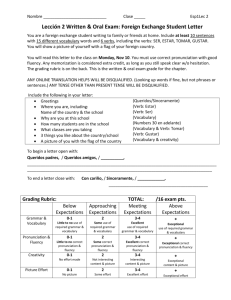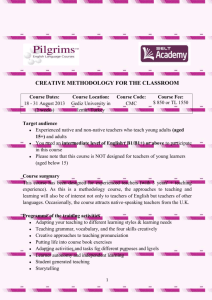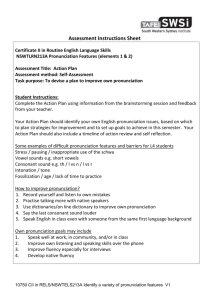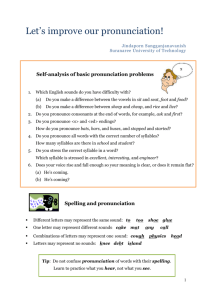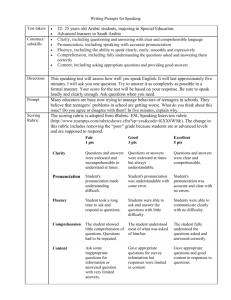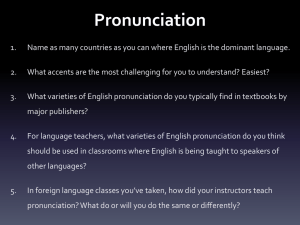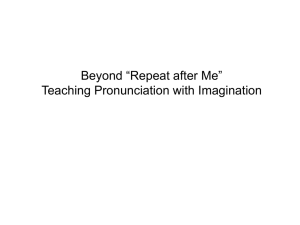G3-S1-KY-Midterm-Key
advertisement
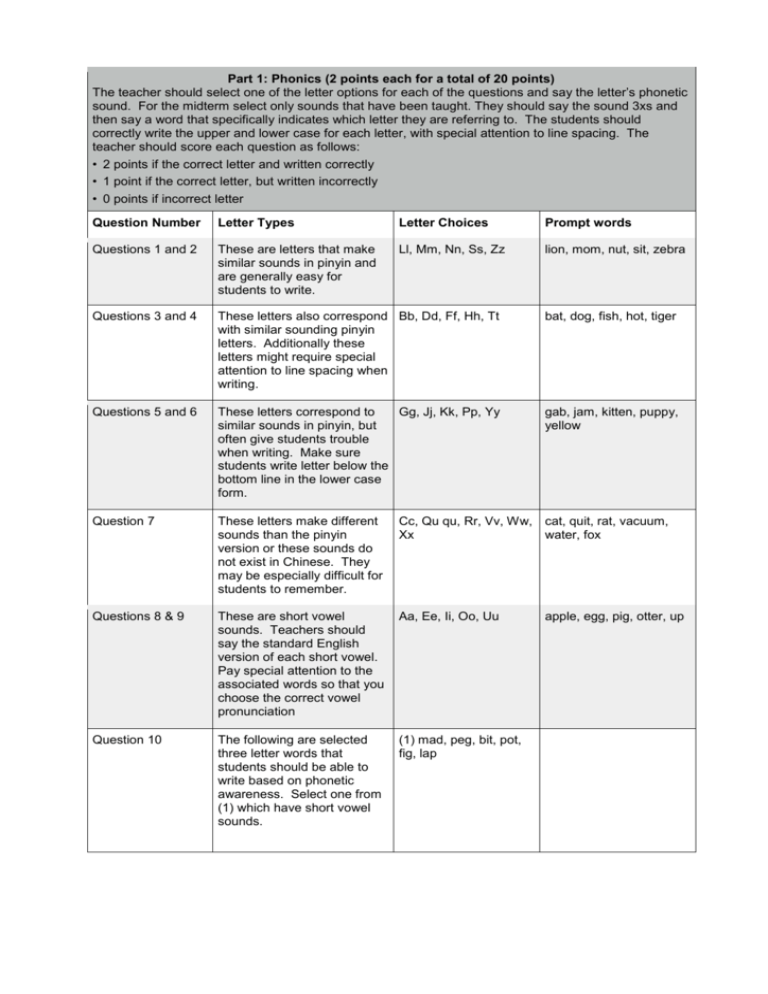
Part 1: Phonics (2 points each for a total of 20 points) The teacher should select one of the letter options for each of the questions and say the letter’s phonetic sound. For the midterm select only sounds that have been taught. They should say the sound 3xs and then say a word that specifically indicates which letter they are referring to. The students should correctly write the upper and lower case for each letter, with special attention to line spacing. The teacher should score each question as follows: • 2 points if the correct letter and written correctly • 1 point if the correct letter, but written incorrectly • 0 points if incorrect letter Question Number Letter Types Letter Choices Prompt words Questions 1 and 2 These are letters that make similar sounds in pinyin and are generally easy for students to write. Ll, Mm, Nn, Ss, Zz lion, mom, nut, sit, zebra Questions 3 and 4 These letters also correspond Bb, Dd, Ff, Hh, Tt with similar sounding pinyin letters. Additionally these letters might require special attention to line spacing when writing. bat, dog, fish, hot, tiger Questions 5 and 6 These letters correspond to Gg, Jj, Kk, Pp, Yy similar sounds in pinyin, but often give students trouble when writing. Make sure students write letter below the bottom line in the lower case form. gab, jam, kitten, puppy, yellow Question 7 These letters make different sounds than the pinyin version or these sounds do not exist in Chinese. They may be especially difficult for students to remember. Cc, Qu qu, Rr, Vv, Ww, cat, quit, rat, vacuum, Xx water, fox Questions 8 & 9 These are short vowel sounds. Teachers should say the standard English version of each short vowel. Pay special attention to the associated words so that you choose the correct vowel pronunciation Aa, Ee, Ii, Oo, Uu Question 10 The following are selected three letter words that students should be able to write based on phonetic awareness. Select one from (1) which have short vowel sounds. (1) mad, peg, bit, pot, fig, lap apple, egg, pig, otter, up Word recognition (10 questions) Students will be given three English words (choices A,B and C). The teacher will say one of these words aloud. The student should identify which word matches the word the teacher said. They should write the corresponding letter in the left column between the parentheses. Question Number and Unit Student Choices Teacher Says Answer Question 1 a) pen b) pencil c) pencil box pencil B Question 2 a) book b) blue c) body body C Question 3 a) this b) thank you c) that this A Question 4 a) head b) hand c) hi hand B Question 5 a) name b) nose c) nice nice C Question 6 a) mouth b) mom c) meet mouth A Question 7 a) fine b) foot c) face face C Part 2: Listening Comprehension (1 point each for a total of 20 points) In this section the teacher will say a vocabulary word or sentence and the student should ✓ or X the prompted picture or word depending on the section. These questions are either right or wrong. No rubric needed. There are three different types of listening comprehension questions. Choose the Correct Picture (4 questions) In this section the teacher will say a sentence. The students are given two pictures that are related by unit. They should write a ✓ underneath the picture that corresponds to the sentence spoken. Question Number and Unit Student Choices Teacher Says Question 1 Eraser or book Show me your book. Question 2 Ear or eye It is my ear. Question 3 Mouth or nose It is my nose. Question 4 Red or Yellow Is it yellow. Question 5 Leg or arm Shake your arm. Question 6 Pen or ruler Show me your ruler. Question 7 Green or blue It is green. Question 8 Bag or pencil Carry your bag. Correct or not (6 questions) In this section the teacher will say a sentence frame with a specific vocabulary word. The students have one picture per question. If the sentence corresponds with the student’s picture, the student should write a ✓. If the sentence does not correspond with the student’s picture the student should write an X. Question Number and Unit Student Picture Teacher says Answer Question 1 Name What’s your name? ✓ Question 2 Crayon Show me your crayons. ✓ Question 3 Two people in conversation I’m fine thank you. ✓ Question 4 Foot It is my face. X Question 5 Head What is this? It is my hand. X Question 6 Purple What color is this? It is purple. ✓ Part 3: The Interview (10 points each for a total of 30 points) In this section the teacher will ask each student three questions. The student should respond in a complete English sentence and say the correct English vocabulary. The teacher can choose from two options per question number. Each option has 4-6 vocabulary words that should be cycled between different students. The teacher may need to prompt the student with a picture of the vocabulary word. Please look at the test for the specific question options. Below is an outline of the rubric to be used for evaluating students. Each question is worth 20 points. 10 of the total points should focus on the student’s ability to answer the question, that is the content of the specific answer. The other 10 points should be based around the student’s speaking abilities. Answer Content (5 points) 6 points of each student answer should be an evaluation of what specifically the student says. Here teachers are evaluating sentence frames, vocabulary, grammar and word order. Score Criteria Speaking ability (5 points) 10 points of each student answer should an evaluation of student speaking style and ability. Here teachers are evaluating pronunciation, fluency, confidence and body language. Score Criteria 5 The student is able to do all of the following: • Sentence frame: Uses appropriate sentence frame to answer the question • Vocabulary: Chooses the correct vocabulary word that the teacher prompts • Grammar: Makes appropriate conjugations (i.e. correct subject I/you/he/she; correct verb am/are/is, etc. • Sentence order: All words in the sentence frame are said in the correct order. 5 The student is able to do all of the following: • Pronunciation: All words in the sentence are pronounced correctly. • Fluency: The student answers the question promptly, they speak at a normal speed and don’t need to pause. • Confidence: The student speaks with enthusiasm and proper inflections • Body Language: The student maintains eye contact, does not fidget, stands straight 4 The student makes one of the following errors: • Sentence Frame: Chooses an inappropriate sentence frame for the question • Vocabulary: Chooses vocabulary word from the unit, but is incorrect for the teacher’s prompt d) Grammar: Grammer error like incorrect subject or verb conjugation (i.e. I is from China. ) • Sentence order: The student says the correct words, but in the wrong order. 4 The student makes one of the following errors: • Pronunciation: The student mispronounces some words, but a native speaker could still understand the meaning. • Fluency: The student takes too long to answer, they speak too fast or too slow, they take too many pauses • Confidence: The student is hesitant or unenthusiastic to speak • Body Language: The student does not maintain eye contact, fidgets, does not stand up straight 3 The student makes 2 of the following errors: • Sentence Frame: Chooses an inappropriate sentence frame for the question • Vocabulary: Chooses vocabulary word from the unit, but is incorrect for the teacher’s prompt • Grammar: Minor grammar error like incorrect subject or verb conjugation (i.e. I is from China. ) • Sentence order: The student says the correct words, but in the wrong order. 3 The student makes two of the following errors: d) Pronunciation: The student mispronounces some words, such that you understand, but a native speaker would have difficulty • Fluency: The student takes too long to answer, they speak too fast or too slow, they take too many pauses • Confidence: The student is hesitant or unenthusiastic to speak • Body Language: The student does not maintain eye contact, fidgets, does not stand up straight 2 The student makes 3 of the following errors: • Sentence Frame: Chooses an inappropriate sentence frame for the question • Vocabulary: Chooses vocabulary word from the unit, but is incorrect for the teacher’s prompt • Grammar: Minor grammer error like incorrect subject or verb conjugation (i.e. I is from China. ) • Sentence order: The student says the correct words, but in the wrong order. 2 The students makes 3 of the following errors: • Pronunciation: The student mispronounces some words, such that you understand, but a native speaker would have difficulty • Fluency: The student takes too long to answer, they speak too fast or too slow, they take too many pauses d) Confidence: The student is hesitant or unenthusiastic to speak • Body Language: The student does not maintain eye contact, fidgets, does not stand up straight 1 The student answers the question by just saying the correct vocabulary word, not in a sentence frame, or in a complete multi-word sentence that is not correct. 1 The student answers the question but makes major pronunciation mistakes that compromise the meaning, takes major pauses, lacks confidence and does not have natural body language. 0 The student makes no effort to answer. Speaks in Chinese. 0 The student makes no effort to answer or speaks in Chinese. Part 4: Advanced Questions (15 points each for a total of 15 points) Use the previous rubric for scoring the content and speaking ability for the advanced questions to score 10 of the 15 points. For the final 5 use the below rubric to try and score the students critical thinking ability. 5 points The student answers the question correctly with 3-5 relevant words and adds words or ideas that go above and beyond. For example the typical description of an animal might include relevant colors and numbers, but an exceptional answer might include body part colors and numbers. 4 points The student recognizes what the question is asking and says 3-5 words in a sentence that is a grammatically correct. 3 points The student recognizes what the question is asking and says 1-2 words in a sentence that is a grammatically correct. 2 points The student recognizes what the question is asking and able to say English words that are related to the question, but does not put them in a grammar structure 1 point The student recognizes certain words in the question or picture, but can only express the ideas in Chinese. 0 points The student does not seem to recognize any elements of the question and makes no effort to try and understand.
